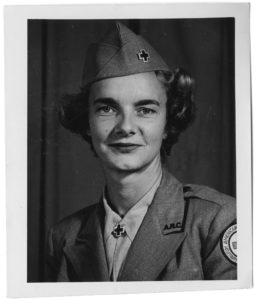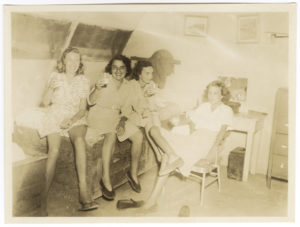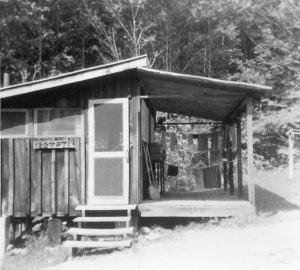By Lilly Lloyd
In the wake of the death of beloved community member Nancy Wrenn on December 21, 2017, the Swannanoa Valley Museum & History Center acquired a collection of personal papers and artifacts from both Nancy and her long-time friend and roommate, Ruth White. Because so much of the collection relates to their time serving with the American Red Cross during World War II, a majority of the collection has gone to the University of North Carolina Greensboro for their Betty H. Carter Women’s Veterans Project. Ruth and Nancy were both teachers at Owen High School and opened Camp Awa-Niko on Jones Cove Road. Ruth and Nancy left a positive and long-lasting impact in the Swannanoa Valley.
 Ruth White was born in Greensboro, North Carolina, in 1922. Growing up she was a member of the Girl Scouts of America and was an avid camper and traveled with her troop. She graduated from Greensboro High School in 1939. Soon after, she graduated from the Woman’s College of the University of North Carolina (now the University of North Carolina at Greensboro). In her college years, World War II was looming over America’s shoulders. After college, she felt she needed to become more politically active and help with the war despite being a strong leader with her college classmates. So she became interested in joining the American Red Cross.
Ruth White was born in Greensboro, North Carolina, in 1922. Growing up she was a member of the Girl Scouts of America and was an avid camper and traveled with her troop. She graduated from Greensboro High School in 1939. Soon after, she graduated from the Woman’s College of the University of North Carolina (now the University of North Carolina at Greensboro). In her college years, World War II was looming over America’s shoulders. After college, she felt she needed to become more politically active and help with the war despite being a strong leader with her college classmates. So she became interested in joining the American Red Cross.
 Nancy Wrenn was born on February 11, 1922, in Southern Pines, North Carolina, “…down in the center of the golf and horse country of North Carolina.” Nancy said in an interview. Growing up, Nancy had horses and would compete in local shows. She loved to camp. She participated in summer camps in Blowing Rock, North Carolina. She graduated from Southern Pines High School in 1939 and graduated from Duke University in 1943. She volunteered with many American Red Cross efforts in her hometown but when a very close friend of hers was killed in the South Pacific, it sparked her interest in branching out and applying for an overseas position in The American National Red Cross Training Program.
Nancy Wrenn was born on February 11, 1922, in Southern Pines, North Carolina, “…down in the center of the golf and horse country of North Carolina.” Nancy said in an interview. Growing up, Nancy had horses and would compete in local shows. She loved to camp. She participated in summer camps in Blowing Rock, North Carolina. She graduated from Southern Pines High School in 1939 and graduated from Duke University in 1943. She volunteered with many American Red Cross efforts in her hometown but when a very close friend of hers was killed in the South Pacific, it sparked her interest in branching out and applying for an overseas position in The American National Red Cross Training Program.

Ruth and Nancy were both accepted to the The American National Red Cross Training Program and had to travel to Washington D.C. to start their training. Ruth and Nancy met at the headquarters and were surprised that they had so many things in common. They were both assigned to the Pacific Theater of War with around 3,000 soldiers and 150 Red Cross personnel. Their first stop overseas was the Philippines. Soon groups began to break off. Ruth and Nancy traveled to New Guinea, Caledonia, and soon after Okinawa, Japan, where they stayed for 17 months. During this time Ruth and Nancy became close friends and started talking about their shared love for camping. They both started talking about possibly building and operating a summer camp when they returned home.
 When Ruth and Nancy arrived back in the United States, they had originally planned to move to Blowing Rock, North Carolina, to start Camp Awa-Niko (Okinawa spelled backward). They soon discovered that Nancy’s stepfather had relatives that were selling land on Jones Cove Road so decided to move to the Swannanoa Valley in 1947. “We just fell in love with the mountainside and we decided that that would be an excellent place to build a camp, and when I say build I mean that because we, over the years built all of our own buildings,” Nancy reminisced in an interview. With help from locals along the way, Ruth and Nancy built camp Awa-Niko, which they operated for 21 summers. Campers learned leadership, pioneering, how to ride horses and much more. There were many fun activities at the camp such as swimming, archery, riflery, and day trips. Mount Mitchell, Craggy Gardens, the Biltmore Estate, and Cherokee were some of the places that they would visit. Campers built lifelong friendships with their campmates and counselors as well.
When Ruth and Nancy arrived back in the United States, they had originally planned to move to Blowing Rock, North Carolina, to start Camp Awa-Niko (Okinawa spelled backward). They soon discovered that Nancy’s stepfather had relatives that were selling land on Jones Cove Road so decided to move to the Swannanoa Valley in 1947. “We just fell in love with the mountainside and we decided that that would be an excellent place to build a camp, and when I say build I mean that because we, over the years built all of our own buildings,” Nancy reminisced in an interview. With help from locals along the way, Ruth and Nancy built camp Awa-Niko, which they operated for 21 summers. Campers learned leadership, pioneering, how to ride horses and much more. There were many fun activities at the camp such as swimming, archery, riflery, and day trips. Mount Mitchell, Craggy Gardens, the Biltmore Estate, and Cherokee were some of the places that they would visit. Campers built lifelong friendships with their campmates and counselors as well.
In the off season, Ruth and Nancy were offered teaching jobs at the Swannanoa High School. Because the Swannanoa High School was such a small school Ruth and Nancy taught many classes. Nancy taught social studies, US history, civics, and world history. Ruth taught general science, biology, chemistry, physics, and physical education. When Black Mountain and Swannanoa High School consolidated in 1955, Owen High School replaced the Swannanoa High School. Ruth and Nancy were able then to teach just two or more subjects. Owen High School eventually transitioned to a 10-month school schedule. This meant that Ruth and Nancy had to close the camp due to the shortened summers. In 1972, they officially closed Camp Awa-Niko. Ruth and Nancy felt that teaching would be more fulfilling in the long run. Many campers have had reunions and continue to carry the memories from camp with them.
In Nancy’s last 12 years of teaching she started an aero-science program at Owen. Nancy loved to fly and had her commercial and private pilot license. Many of the students enjoyed the aero-science program and went on to join local private jet lines, the Navy, and relief programs. The aero-science program brought a wonderful influence on the students, but that’s not the only class that was impactful. In letters written to the women they were told that they made the difficult subjects fun and worthwhile. They were both acknowledged as teacher of the year at Owen and received the Close Up North Carolina: Teacher Appreciation award. Ruth and Nancy were heads of the Beta Club and were loved by students and faculty. Both women retired in 1982 but continued to go to class reunions and gatherings for the school. In fact, Black Mountain’s mayor at the time proclaimed that June 7, 1982 would be Ruth White and Nancy Wrenn Day.
 Here at the Swannanoa Valley Museum some of the highlights of our Wrenn/White Collection are Ruth’s Red Cross uniform, a Camp Awa-Niko Bible, many of Ruth and Nancy’s certificates, and Ruth and Nancy’s self-published book, Jones Cove Road: Memories and Stories. Without Ruth and Nancy we would not have been gifted our large barn loom, one of the center pieces of our collection. We will treasure and conserve these items for the public to enjoy.
Here at the Swannanoa Valley Museum some of the highlights of our Wrenn/White Collection are Ruth’s Red Cross uniform, a Camp Awa-Niko Bible, many of Ruth and Nancy’s certificates, and Ruth and Nancy’s self-published book, Jones Cove Road: Memories and Stories. Without Ruth and Nancy we would not have been gifted our large barn loom, one of the center pieces of our collection. We will treasure and conserve these items for the public to enjoy.
This post was written using sources from the Swannanoa Valley Museum & History Center and the Betty H. Carter Women Veterans Historical Project.
